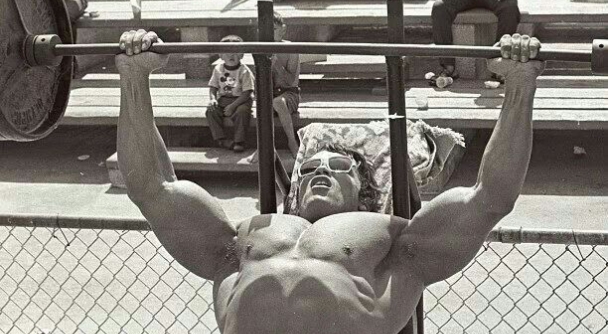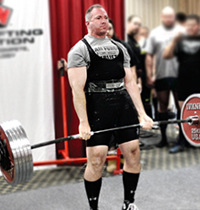4 Strategies for a Bigger Bench


By Tim Henriques
You want a bigger bench, I want a bigger a bench, everybody wants a bigger bench. The only people that exercise but don’t want a bigger bench are those that aren’t good at it and they have convinced themselves the lift doesn’t really matter - but deep down they still wish they benched more. As a powerlifting coach, I have had lots of people come to me looking to add some poundages to their bench press. Here are 4 strategies that are sure to build your benching prowess:
Gain Weight
Talk with any big bencher and they will tell you getting big has helped their bench press. This is something that most “in the know” lifters are aware of but nobody seems to be clear on how it works. Some say it increases your leverage, others say it fills up your cells. None of that is the reason why your bench goes up when you gain weight. The truth is that your joints are very sensitive to their internal stability, we have proprioceptors inside our body that sense and detect things for us. Your body can detect when a joint is stable or not. When it is not stable, the body will inhibit (shut down) some of the muscle force that can act on that joint. You can see this very easily by performing a pull-up and then use one less finger each time to grasp the bar. Most people when they get down to 2-3 fingers are no longer able to do a pull-up. The weight didn’t change (your bodyweight), your lats didn’t change, but the stability did change and now you can’t perform the exercise.
What is the most flexible joint in the body? The shoulder. Because it is so flexible it isn’t very stable, and it relies on muscle and surrounding tissues to derive some of its stability. As you gain weight by adding muscle you will increase that stability. Honestly even adding fat will serve as a wrap which add stability to the shoulder girdle and thus increase the potential force that can cross it. I am not a proponent of them but this is one reason why bench shirts work so well, they surround the shoulder joint and greatly add to the stability which is one reason why they add so dramatically (about 30-50% if you can believe that) to the lift.
When I moved up from the 198 lb weight class to the 220 lb weight class (approximately a 20 lb increase) my bench went up by 50 lbs. I’d love to tell you I was benching 2.5 x bodyweight at the time but alas I can’t say that I was. The point being that the added weight didn’t just up my max, it even increased my relative strength at the same. Of all the competitive lifts, the bench is the most sensitive to changes in weight. The good news is that on the bulking cycle you can definitely expect to slap some more weight on the bar, the bad news is that as you lean up it is likely that your bench may go down, particularly if you are already at an advanced level. But if you are stuck on a plateau try gaining 10 lbs and see what happens to your lift.
Cluster Sets
A cluster set is where the lifter will perform one rep, they rest 10-30 seconds, and then they perform another rep. This continues until the desired reps are completed. Then the lifter can take a full rest and either repeat that or move on to another exercise. A cluster set is an intensity technique, most intensity techniques are beneficial for size because they force the lifter to train in a fatigued state. This technique actually manages fatigue - it is easier to use this method than to just perform a normal set. That in turn means the lifter can use more weight and can complete more reps, which is ideal for increasing maximal strength.
I have found that there are two ideal ways to incorporate cluster sets into your workout. The first is just to perform one big set which I refer to as a single cluster set. With this method you will take about 90% of your 1RM or a weight you know you can hit for 4-5 reps. Use this weight for your cluster set, rest 20-30 seconds in between each rep (actually rack the bar, sit up, take a few deep breaths, and then perform another rep). You can go for anywhere from 5-20 reps with this style, I have found that 10 reps is a good sweet spot. Hit your target reps and then stop. When you repeat that exercise again (likely the following week) add 5 lbs (2.5 lbs if benching under 200) and go again. Here is a video of this style of cluster set:
The second effective way to incorporate clusters is to do them volume style, which I refer to as multiple cluster sets. As the name implies you will perform more than 1 set like this. I have found 3-6 reps to be ideal with this method, combined with 3-5 total sets. Take about 85% of 1RM, perform one rep, rest 10-20 seconds, repeat for 3-6 reps. Rest 2-3 minutes and do that about 5 times. Just like the previous cluster set, add a small amount of weight when you repeat this workout. Here is a video of the multiple cluster set:
Clusters are fantastic and one of my favorite training methods for building strength. Like all strategies though, they don’t work forever, I like to use them in 6-12 week long blocks, adding weight each week. I have found them to be particularly effective for bench, front squats (back squats not so much), rows, pull-ups and curls.
Negatives
A lot of lifters will throw in a negative here or there in the workout but they never really systematically program them into the workout. Negatives are another effective strength building tool. With a negative you will perform a 4-10 second eccentric contraction – in the case of the bench press you will slowly lower the bar to your chest. Unlike traditional negatives where you simply complete a set and then make that lest rep a negative, this time the entire set will consist solely of negatives. However, we are not performing 8-10 reps, negatives are very damaging to the muscle and will leave you sore and fatigued in a hurry. I have found that 2-4 sets of 2-4 reps works very well, 4 sets of 3 is probably my favorite arrangement.
The key to making negatives effective is the concept that the bar never free falls during the lowering portion. Imagine if your workout partner yelled out “Hold it” on the negative, you should be able to stop the bar at the moment and hold it for a second or two. If you can’t you are not doing it right. The other key point is don’t waste your energy at the top. You are very strong in the top portion of the bench, so don’t waste your time going super slow there. You can move through the first quarter of the ROM pretty quickly and then lower it under control. For negatives to help your bench, the form on the negative needs to mimic your form when you lower a real bench press. Wrists straight (or at least close to this), elbows tucked 45-60 degrees, normal bench set-up, and make sure the bar path matches your normal bench and that the bar lands in the right spot on your chest (usually right at the nipples or just below – not below the bottom of your sternum).
For this start with about 95% of your 1RM, so here we are going heavy. If you are using this with the clusters mentioned above, then make this 10-20 lbs heavier than that single cluster set. Lower reasonably slowly, I like to count to 6 in my head. One downside of this method is that you will need a good spotter(s) for this method. You are NOT pressing the bar up, as soon as the bar hits your chest the spotter will lift it up for you. You can press about 50-60% of the weight and the let the spotter do the rest, this is not the time to see if you can press it, save that for the max out. I have found once you are using about 350+ lbs on negatives you may want to move to 3 spotters to make it easier to lift up. On my very last rep of my very last set I often like to do an extra slow negative – I’ll shoot for a ten count in my head to really establish control of the bar.
Negatives build strength and they can help lifters overcome mental blocks with the bench press – sometimes a lifter is so excited about benching 3 plates that the weight seems kind of scary. Females really benefit from this training as well as their body gets used to handling heavier and heavier weight. I have had lots of females bench their bodyweight or more in a competition (which is a nice bench for a female) using these methods. Here is a video of negatives in action:
Two-a-days
the last strategy is to take a page from the football players and other serious athletes and incorporate 2-a-days. Workout twice a day and train the bench each time. You might think that on the second workout you’ll just be destroyed and it will have to be a light, machine-based endurance workout but I found that not to be the case. If you just completely smash your chest for an hour with 5 exercises, 6 sets each in traditional bodybuilding fashion then that may be true, but if you train with reasonable volume and a pretty high intensity (30-60 reps on the bench, none of them until true failure) in the first workout you might find that you are just as strong if not stronger on the second workout and you can go even heavier.
I like to rest at least 2 hours, preferably 4-5 hours between the first and second workout. Eating once is key, twice is optimal, to promote recovery. Your endurance may well be a bit limited on that second workout, but you may also find that your nervous system is still primed from the previous workout and you are ready to dominate some weight. Make the workout short and sweet, 10-25 really productive reps on the bench is all you do need for this second round. You’ll likely find the additional practice time refines your technique and makes you feel very comfortable when benching heavy weight.
The 4 methods described above are some of the strength building strategies I use with my powerlifting team and my personal training students and they never fail to deliver results. I cover their implementation in more detail in my book All About Powerlifting. The next time somebody asks “How much do you bench?” wouldn’t you like to say “more than I did 3 months ago.” That is, after all, what this game is all about.
ABOUT THE AUTHOR

Tim Henriques is the Director of the National Personal Training Institute of VA/MD/DC. NPTI is a 600 hour, 6-12 month long school for people who wish to become personal trainers. Tim is also a competitive powerlifter and he is the coach of his powerlifting team - Team Force. Apart from powerlifting, he has competed in armwrestling and strongman competitions. Tim set the USAPL VA state record for the deadlift with a lift of 700 lbs at a bodyweight of 198 lbs. He regularly gives presentations, writes articles, and lectures on strength and fitness and he authored the comprehensive book All About Powerlifting which is now available. He is lifetime drug free.
Website: http://www.nptivirginia.edu
Website:: http://allaboutpowerlifting.com
